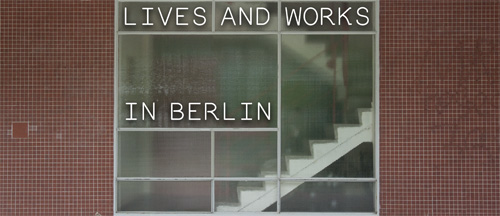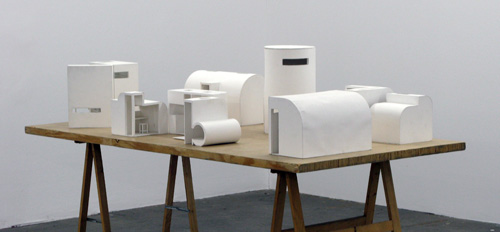It was back in 2005 when I first encountered the work of Absalon at Berlin’s Hamburger Bahnhof in a exhibition called Fast Nichts – Minimal Artworks from the Friedrich Christian Flick Collection (fast nichts means “almost nothing” in German). In many ways, if you’ve been to Dia: Beacon, you’ve seen a good portion of Fast Nichts — works by Carl Andre, Blinky Palermo, Bruce Nauman, and so forth. One of the (admittedly numerous) exceptions to the above claim is the work of Absalon. Somewhere in my digital archive, I still have a few the photos I took of his work, Cellule No. 2 (Protoype) (1992). While wandering through the vast halls of the Hamburger Bahnhof’s Reickhallen, I was immediately taken by the human-scale (but still quite small), white igloo-like structure that essentially has no more room than that which one might need to live. The house, or cell, or cellule, not larger than two queen-sized beds put side-by-side, consists of a desk or table, a sleeping area that is rather tomb-like, and an small stall that features a prototypical shower/toilet combination.
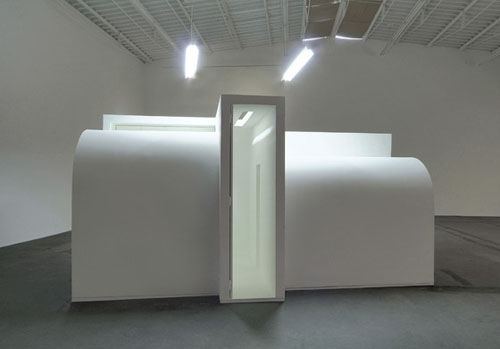
Absalon, "Cellule No.2.," 1992 Friedrich Christian Flick Collection im Hamburger Bahnhof, ausgestellt 2005 in den Rieckhallen © Estate of Absalon Foto: Roman März.
The outer shape of the structure dictates the inner, and vice-versa; odd bump-outs encompass the variously-purposed areas; a visitor must most-often hunch to access some areas of the Cellule, and certainly a museum guest must not attempt to bring their backpack, or a friend, inside with them. No conjugal visits in these cell(ule)s. This same piece was also exhibited again recently as part of the extended exhibition of the Bruce Nauman’s Dream Passage exhibition at the Hamburger Bahnhof in 2010, along with Absalon’s short video work Bruits (1993), in which the artist screams at the camera until he no can no longer, his voice temporarily ruined. Installed at the Hamburger Bahnhof, or probably anywhere else for that matter, you can hear his pained screams much sooner than you find out what they are coming from. Certainly, most of Abalon’s other works are much much quieter in every way.
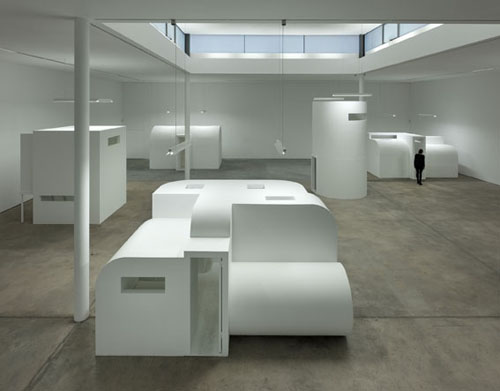
"ABSALON" installation view at KW Institute for Contemporary Art, 2010. From left to right: "Cellule No. 6 (Prototype)," 1992; "Cellule No. 3 (Prototype)," 1992; "Cellule No. 1 (Prototype)," 1992; "Cellule No. 5 (Prototype)," 1992; "Cellule No. 2 (Prototype)," 1992. Photo: Uwe Walter, 2010.
Fast-forward to 2011, and you have ABSALON at Berlin’s Kunst-Werke – Institute for Contemporary Art (KW). The “self-titled” solo exhibition ABSALON is the first comprehensive solo show of the Israeli artist Absalon, (born Meir Eshel) since 1994, one year after his death at the age of 28. The central focus of the exhibition is his Cellule (1992) series, Numbers 1 – 6, all in one room in full-scale. Absalon’s plan for each of these equally staid and practical structures, all with different designs and layouts, was to plant them in 6 cities around the world, where he would have then lived in them, as he resolved to do in 1992. It’s an impressive sight, seeing KW’s vast central hall filled with six diverse but similar options for living simply. The bright white paint of the Cellules is magnified by the white fluorescent lights that illuminate the outside as well as the inside of the structures, in addition to the white walls of the hall, creating a strange Heaven-like space for the buildings.
Visitors are enabled to enter all but one of the structures (some are “exhibition copies” made specifically for this installation) and imagine themselves living a life pared-down in the house of their choice. While Cellule No. 6 is nearly a cube and Cellule No. 5 is cylindrical, the others have more organic shapes, again dictated by intended usage of the spaces they contain. In addition to the full-scale Cellule prototypes, there are detailed sketches, 1:10 scale models and measured drawings of the 6 variants, which offer an insightful glimpse behind the scenes and into the development of these abodes that bring to mind the Vitruvian Man, childhood forts, and futuristic prison cells.
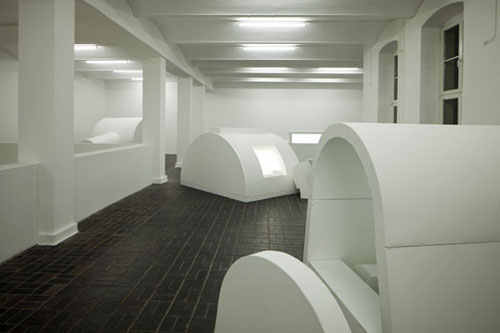
Absalon, "Cellule No. 5," 1991. Installation view at KW Institute for Contemporary Art, 2010. Wood, cardboard, white dispersion paint, neon tube, perspex 350 x 215 x 48 cm. Courtesy Musée de Grenoble. Photo: dreusch.loman, 2010.

Absalon, "Cellule No. 5," 1991. Installation view at KW Institute for Contemporary Art, 2010. Wood, cardboard, white dispersion paint, neon tube, perspex 350 x 215 x 48 cm. Courtesy Musée de Grenoble. Photo: dreusch.loman, 2010.
Another series of Cellules in a somewhat more furniture- or tent-like scale is included, which one associates more with space travel or concept cars than the practical, albeit minimal living of the larger series. Sure enough, there are many smaller models of these works as well, and in the attic gallery of KW, Absalon’s Disposition (1990) lays spread out over 110 square meters; imagine a large-scale (all white) Lego set and you come close to imagining Disposition. 40 complex elements in white painted wood and cardboard are shown as investigations into shapes and forms. Using basic shapes (cube, cylinder, cone and sphere, for example), Absalon combines and carves these shapes to create the building blocks to a city of Cellules.
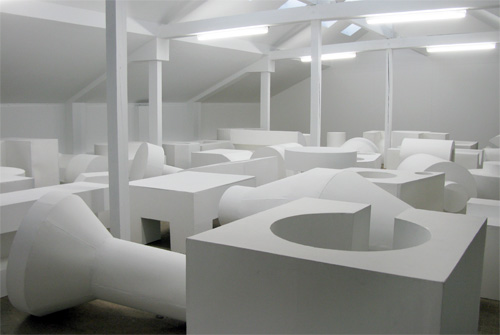
ABSALON: "Disposition," 1990. Installation view, wood, cardboard, white dispersion paint, 6 neon tubes, 40 elements 140 x 928 x 1028 cm; 110 square meters. KW Institute for Contemporary Art, 2010 Courtesy Collection du Fonds régional d’art contemporain Languedoc-Roussillon. Photo: Ethan Hayes-Chute, 2010.
Various videos accent the show: installed in the stairwell, indeed, Bruits can be heard from various levels of KW; the “YouTube-short” Assasinats (1993) is a great 33-second film of the artist “shivving” unsuspecting businessmen-types as they get out of cars or elevators; Battaile (1993) is another quickie but a great take on the mime-in-a-box genre, with Absalon trying with all his might to punch and thrust himself free of the TV-safe Cellule in which he will be forever contained.

